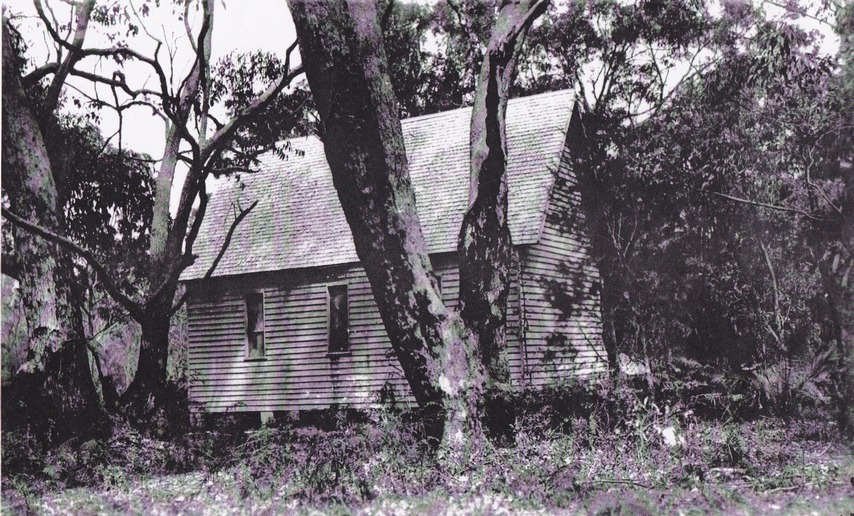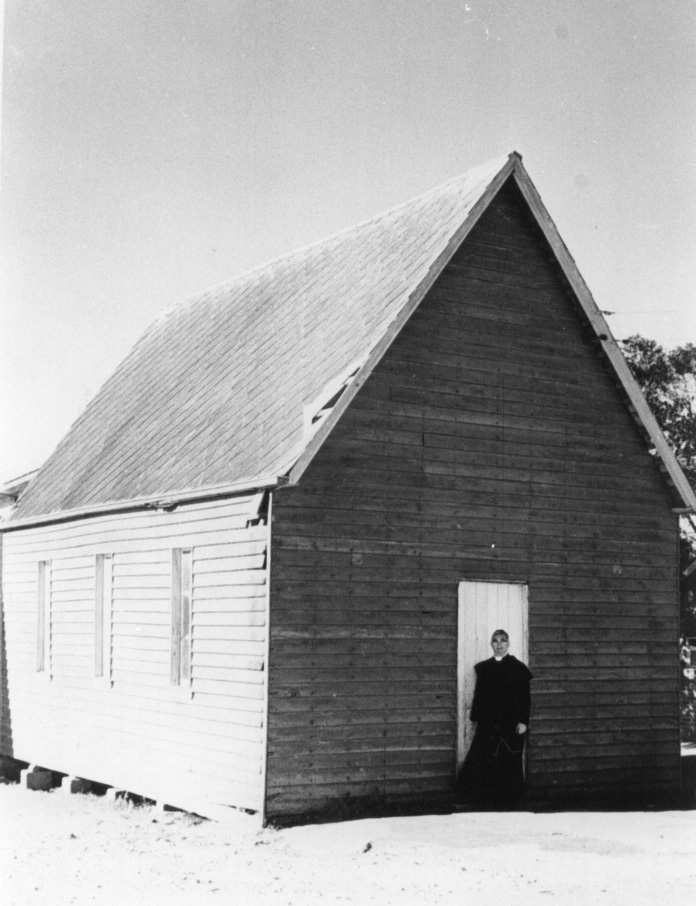May 8-14, 2011: Issue 5
Archpriest John Joseph Therry
1790 - May 25, 1864

Born in Cork and educated at St Patrick’s, Carlow, Therry was ordained in 1815 and did parochial work in Dublin and Cork before sailing to Sydney in May of 1820 aboard the Janus, a transportation ship carrying over 100 Irish men and women convicts. He had seen these fellow Hibernians being dragged to the docks in chains for transportation, and hearing they had no priest, applied for and was accepted as a missionary. The voyage took four months. Prior to his arrival in Australia Catholic convicts and freemen’ were to attend the Anglican services or be deprived of meat or flogged, 20 lashes increased to 25 lashes for a second refusal to attend what they considered ‘heretic’ services. The Catholic priests who were here had been transported for their involvement in the Irish Rebellion and were not allowed to conduct services as they too were convicts. Many of those transported had been associated with the Rebellion so attending Anglican services, those conducted by the ruling elite, was anathema to them.
From the outset Father Therry endeavoured to better the lot of his congregation and frequently incurred the ire of those who feared another uprising from those they governed in the fledgling colony. One third of those living here then were Irish Catholics. He may have spoke his mind, saying out loud what many were thinking but afraid to voice, and a sharp wit may have pricked some egos, but he professes a wish not to offend and a sense of surety of his work and his authority to perform it;
“Lest any zeal which I may occasionally manifest for the preservation in this Colony of the holy religion of which I am but a very humble minister should excite in your mind a suspicion that I dislike persons of the other persuasions, I now distinctly declare that it is my desire, as far as it is possible, that is, as far as it is consistent with paramount duties, to be in peace with all and to give offence to none ; that I dislike no man on account of his Religion; that I respect a moral man whatever religion he may belong to” (Letter. July, 1826.)
His association with Pittwater came through a land Grant in 1833. Some sources state he was given 1200 acres, others cite 1400. Either way this area ran from Newport to Careel Bay and encompassed most of Avalon. Published in the Government Gazette lists:
113. Thomas Warner, 50, Fifty Acres, Parish of Narrabeen, commencing at the Northeast corner, and bounded on the East by a side Hue of twenty-five chains; on the South by a West line of twenty-five chains to Pitt Water; and on the West and North by the waters of Pitt Water to the commencing corner.
Promised by Governor Macquarie on 31st March, 1821. Quit-rent Is. sterling per annum, commencing 1st January, 1827.
114. Henry Gaskin, 50, Fifty Acres, Parish of Narrabeen, commencing at the North-east corner of Warner's fifty acres, and bounded on the West by a South line of twenty-nine chains; on the South by an East line of twenty chains ; on the East by a North line of twenty four chains to Pitt Water ; and on the North by the waters of Pitt Water to the commencing corner. Promised by Governor Macquarie on 31st March, 1821. Quit-rent Is. sterling per annum, commencing 1st January, 1827.
115. John Joseph Therry, 1200, One thousand two hundred Acres, Parish of Narrabeen, commencing at the South-east comer of the Government Reserve of two hundred and eighty acres, and bounded on the North by that Reserve by a line West twenty-five chains to a Stream ; on the North by that Stream and Careel Bay to the North-east Gorner of Henry Gaskin's fifty acres; on the West by Gaskin's by a line South twenty-four chains ; on the South by a line West twenty chains, and again by a line North four chains to the South-east corner of. Warner's fifty acres; on the North by Warner by a line West twenty-five chains to Pitt Water; on the West by the waters of Pitt Water to the North-west coiner of John William's sixty acres ; on the South by that farm by a line South fifty degrees East 38 chains ; on the West by a line South forty decrees West sixteen chains ; on the North by a line North fifty degrees West thirty-nine chains to the North corner of John Taylor's thirty acres ; on the West by Taylor by a line South twenty three chains to Pitt Water ; on the West by the waters of Pitt Water to the North-west corner of James M'Donald's thirty acres ; on the South by that farm by a line East eleven chains ; on the West by a line South twenty-three chains to Robert Melvyn's sixty acres; on the South by part of Melvyn's farm, and by Porter's and Anderson's farms by a line East fifty chains to Martin Burke's fifty acres; on the East by that farm by a line North six chains to a Stream ; on the East by that Stream, which is the Western boundary of John Farrell's sixty acres; on the South by that farm by a line East twenty-eight chains to the Village Reserve of one hundred acres ; on the East by part of the Village Reserve by a line North seven chains to a Stream ; on the South by that Stream, which is the North boundary of the Village Reserve to the Sea; and on the East by
the Sea to the commencing comer. Promised by Sir Thomas Brisbane, 200 acres,on 23d July, 1824 ; 500 acres on 1st September,1824; and 500 acres on the 19th December,1825. Quit-rent £9 8s. 4d. sterling per annum, commencing 1st January, 1829. Classified Advertising. (1832, November 1). The Sydney Gazette and New South Wales Advertiser (NSW : 1803 - 1842), p. 1. Retrieved from http://nla.gov.au/nla.news-article2209217
Friends at Clareville still hold documents of when their father’s father father purchased land with Father Therry’s name listed as owner. Pittwater’s first church at Careel Bay; St Josephs, a small one room wooden church with a shingle roof, built in early 1870, was a Memorial to John Joseph Therry and stood near the present corner of Joseph (or George) and Therry Streets with farm lands around it that went back to bush. Catholic settlers of the area were fortunate if the church was opened once a year for Mass. The little church, known as the Barrenjoey Church of St Joseph’s, (the Catholic patron saint for workers) even though it was known as Father Therry’s, was not actually built until after his death.
Josephton was established on the shores of Careel Bay for his workers. These sought coal at Avalon Golf Course, farmed and collected shells for the manufacture of lime. One of many wills he wrote illustrates his plans for his farm here:
"I desire that my farm of eighty acres, formerly known as Peter Petitta’s farm at Pitt Water, which is beautifully and most advantageously situated, should be divided into four equal parts of twenty acres each which are intended as the sites for educational establishments for the Benedictines, Jesuits, Franciscans, and the French Mission of the Propaganda respectively.”
Also “to the land property with which I have been blessed, namely to establish five villages which are likely to become respectable towns the principal one at Pitt Water to be called Josephton” (Life and Letters. 1922). Other documents state he planned to call the whole district Josephton and Avalon was to be named Brighton.
What is certain is that Careel Bay, with its creek and sheltered cove, must have seemed ideal to his eyes, a place to dwell in quietly as respite from all his endeavours through the colony and elsewhere in Australia. Therry’s plans to build a church at St Michael’s cave illustrate the openness and beauty here kindled a rapport with the natural landscape and a sense of its innate sacredness in his heart.
A description of one of his visits here:
PITT WATER.
Yesterday, being Easter Monday, a pleasant steam excursion took place in connection with the St Benedict's Young Men's Society. The commodious steamer the Collaroy, under the command of Captain Mulhall, had been chartered for the occasion, and left the Australasian Steam Navigation Company's Wharf, Sussex-street North, with about 260 persons on board, at ten o' clock a.m. Part of the band of H. M. S. 12th Regiment were in attendance, their cheerful and untiring efforts contributing not a little towards making the day pass harmoniously and agreeably away.
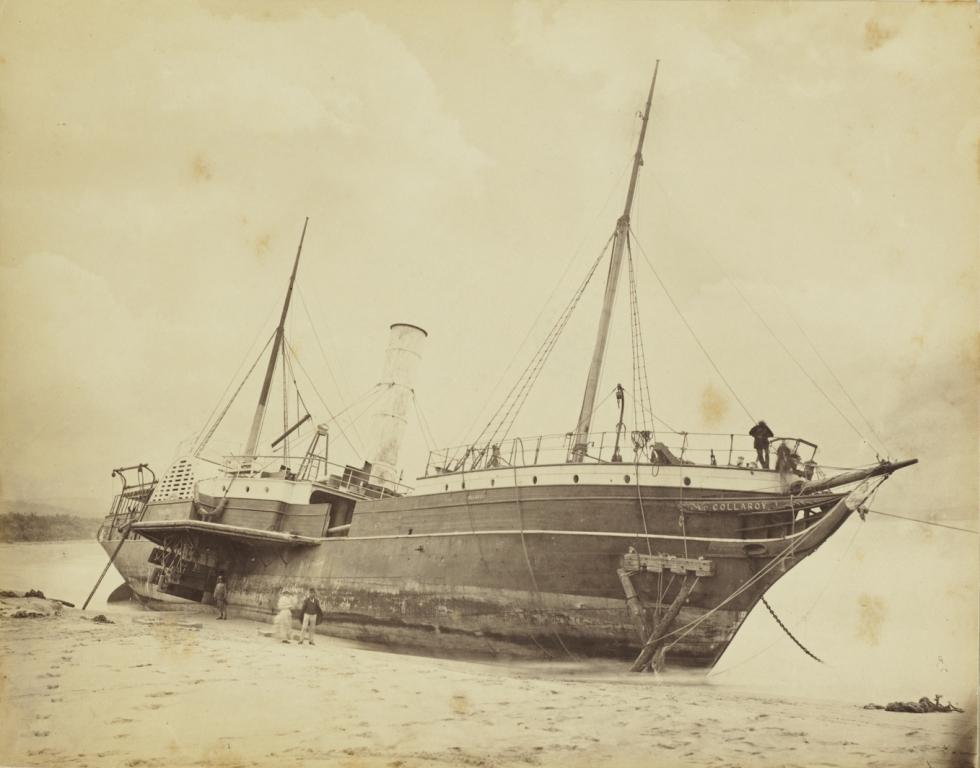
Wreck of the S.S. Collaroy, 1881 / photographer unknown. State Library of NSW Image No: a1528938: A passenger steamer owned by the Australian Steam Navigation Company, built in 1853, went ashore on Collaroy Beach in 1881 and remained there for almost 3 years, giving her name to the stretch of sand and ocean. When refloated she went back into service plying between Sydney and the Hunter River. She was withdrawn from duty in 1886, converted to a schooner, sailed to San Francisco, where she again ran ashore and broke her back on the Californian Coast in 1889.
Working along through the ever changing scenery displayed on the shores of our harbour, the Collaroy at length rounded the Heads, and, taking a northerly course, rushed past that enormous barrier presented by the weather-worn cliffs which face the ocean between the Great North Head and the seaward aspect of Manly Beach. Following on the interesting coast line of Curl Curl, Dee why, Long Reef, and Narrabeen, &c, - varied succession of wooded eminences, long sandy reaches, towering precipices, and grassy park-like slopes, - the pleasure-seekers were at length abreast of the singular headland of Barrenjoey, forming the extreme south-eastern limit of the estuary which serves as a common outlet for the River Hawkesbury and the Pitt Water. Shortly after passing the Custom House station the course of the Collaroy then took a southerly direction, and so brought the holiday folks into the lake-like solitudes of Pitt Water, until wooded hills seemed to be rising on every side of the vessel.
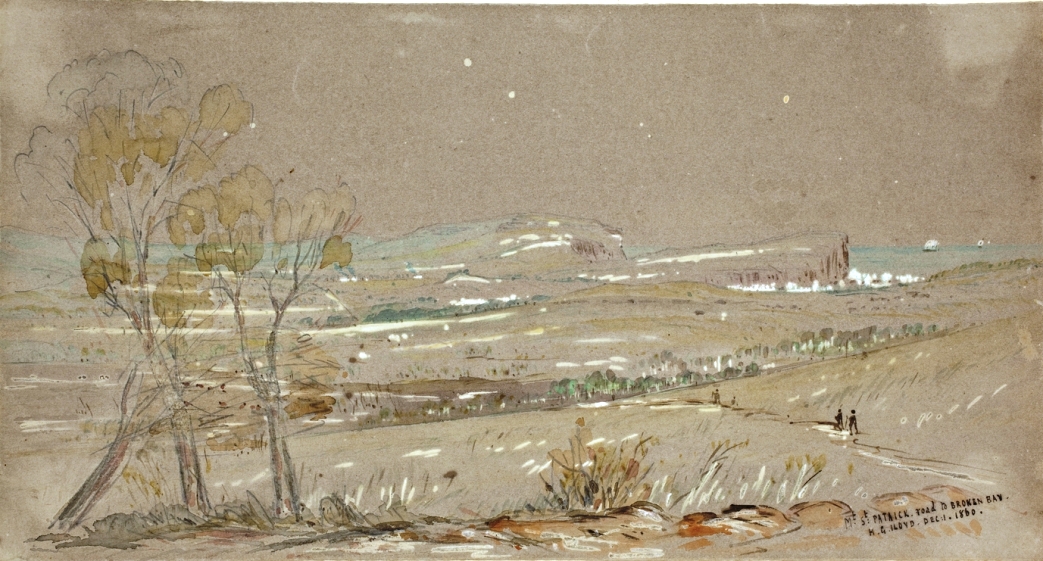
The passengers were landed at a small, but commodious wharf, erected on the property of the Venerable J. J Therry, under whose especial patronage the excursion had been got up. Most of the visitors set off in quest of St. Michael's Cave, determined not to lose the opportunity of seeing so great a natural curiosity. The walk, it was found, lay through woods, a long flat, and a hilly scrub, until, facing to the east at the head of the inlet, the merry party, in a straggling Indian file, at length arrived in the vicinity of the cave, cautiously descending the rocks, and creeping carefully along a narrow path specially made for their convenience on the face of the cliffs, they were thus finally rewarded for their perseverance. Almost every body managed to scramble up into the cave, and not a few of the more adventurous explored its inmost recesses by candle-light. The effect of the gloomy inner arch looked down upon from the top of the second angle of the cave, was much admired; and so also was the wider arch at the entrance, as contemplated from the spot where the bright daylight again began to stream down upon the faces of the returning explorers. There was, for some time, a pleasant buzz of conversation and a discussion of food at the mouth of St Michael's Cave, and then the party set out on their way back to the steamer, where dinner had been prepared.
Some with sharpened appetites posted thither at once, but many remained with the band near the house on the flat, and amused themselves with dancing, playing cricket, and so on. There was some dancing also at the steamer after dinner was over. The Kembla steamer visited the wharf at an early hour, landed some passengers, and afterwards returned for them. The Collaroy left the wharf for Sydney at about five o'clock, and arrived safe at Sydney soon after eight. The Right Worshipful the Mayor of Sydney, the Mayoress, and other members of the family were on board. We also observed the Rev. Fathers Corish, Curtis, Hanson, and Powell, besides the Venerable J. J. Therry. The trip appeared to give general satisfaction, although a slight shower, soon after the arrival of the Collaroy at Pitt Water, interfered with some of the arrangements.
PITT WATER. (1862, April 22). The Sydney Morning Herald (NSW : 1842 - 1954), p. 4. Retrieved from http://nla.gov.au/nla.news-article13227471
DEATH of the REV J.J. THERRY
{From Thursday's Herald.)
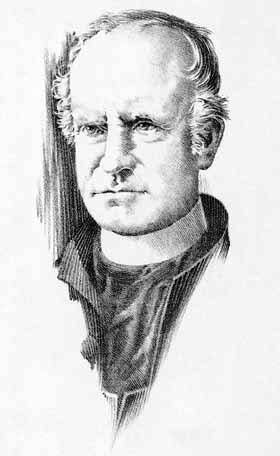 The announcement of the decease of this venerable clergy man will, notwithstanding his advanced age, be received with surprise, the more particularly when it is stated that he appeared in perfect health up to within two hours of the illness which carried him to his grave.
The announcement of the decease of this venerable clergy man will, notwithstanding his advanced age, be received with surprise, the more particularly when it is stated that he appeared in perfect health up to within two hours of the illness which carried him to his grave.References and Further reading:
- TROVE - National Library of Australia
- Shelagh Champion OAM and George Champion OAM, in their Profiles of the Pioneers in Manly, Warringah and Pittwater (1996 - revised 2013)
- Archpriest John Joseph Therry
- John Collins of Avalon - Pittwater Patriarchs Series I
- Maria Louisa Therry - Pittwater Matriarchs Series I
- Careel Bay Steamer Wharf And Boatshed
- The Mulhalls Of Broken Bay And Barrenjoey - Australian Champions
- Light Keepers of Barrenjoey Lightstation
- Captain Francis Hixson
- The Collaroy Paddle Steamer: New Ephemera Added To Public Accesible Records - Her Connections To Pittwater
- Albert Thomas Black
- John Black
The Marriage dollar said to have been loaned to financially embarrassed bridegrooms by Father Therry to pay for their marriage service; FROM: http://www.stmaryscathedral.org.au/about-us/historical-exhibition.html
Parents: John Therry and Eliza (nee Connolly); remained in Cork.
Brothers: James and Stephen Therry, the former of Hobart Town, the latter of Cork, Ireland. Sister: Jane Ann Therry of Hobart Town.
Therry, J J, Rev Waterlily (schooner) Sydney (1845 Jul 6) to Hobart Town
Therry, J J, Rev James Watt (steamer), 142 tonsHobart Town (1845 Feb 10) to Sydney (1845 Feb 16)
Therry, J J, Rev Velocity (schooner) Sydney (1846 Sep 19)to Port Phillip (1846 Sep 25)
Therry, John Joseph, Rev Esther (ship) Sydney (1833 Sep 5) to Norfolk Island
From; http://www.blaxland.com/ozships/alpha/pass/s287.htm
Character and Conduct of Reverend Therry
DESPATCH FROM GOVERNOR DARLING TO EARL BATHURST – DATED 6/9/1826
‘Your Lordship will perceive that Rev. Therry is a man of strong feelings and not much discretion. He is evidently disposed to be troublesome, and, constituted as the community is, might be dangerous, a large proportion of the convicts being of the lowest class of Irish Catholics, ignorant in the extreme, and in proportion bigoted and under the domination of their Priest. He is indefatigable in his endeavours to preserve his influence amongst his countrymen, and is constantly going from place to place with this view. From the similarity, he can hardly fail to succeed......
I must confess to your Lordship that I have no desire to see any more of the Clergy of the Catholic persuasion here. The good they might affect through the medium of education is counteracted by the subjugation of mind, in which those under their influence are kept.
Mr Therry is anxious for the completion of his church, but though fully disposed to assist in this object, as far as your Lordship has directed, it is not in my power to do so at present without interrupting the progress of some of the public buildings. I have informed him that, so soon as I possess the means, I shall afford him the necessary aid.......
I understand Rev Therry is acquiring wealth, and, as his influence will increase with his means, his immediate removal appears the more desirable. I would beg to point out that, in selecting a Catholic Priest for this Colony, it is most important that an Englishman should have the preference, the Catholics here being, I believe, nearly all Irish’.
[Historical Records of Australia, Series 1, Volume 12, pp 543-44].
Unwillingness of Reverend Therry to Leave
EXTRACT FROM DESPATCH OF GOVERNOR DARLING TO EARL BATHURST – DATED 18/11/1826
‘On communicating to him [Reverend Therry)] the Orders of His Majesty’s Government, he informed me .... though deprived of salary which he observed he had intended to relinquish, he should consider it incumbent on him to continue his assistance to the Roman Catholics, until the arrival of some accredited Clergyman from Home.
He stated that it was not his intention to leave the Colony, though, if required to do so, he should not resist the Orders of Government. It has not, however, appeared to me advisable to give such an order, as I do not anticipate any evil consequences from his continuing his assistance, until the arrival of his successor; and any order for his immediate removal would in all probability have called forth some expression of the public opinion in his favour, which is as well avoided and might for the moment have excited an unpleasant sensation’.
[Historical Records of Australia, Series 1, Volume 12, p 693].
Therry remained in the Colony despite his suspension and continued his work as a chaplain without salary.
From: http://www.cathchurch.net/nsw/parish/Pittwater.htm
http://www.holidayoz.com.au/pittwater/narrabeen/history.htm
Below: LIFE AND LETTERS OF ARCHPRIEST JOHN JOSEPH THERRY
FOUNDER OF THE CATHOLIC CHURCH IN AUSTRALIA
BY Rev. ERIS M. O BRIEN PROFESSOR OF AUSTRALIAN HISTORY IN ST. PATRICK'
ECCLESIASTICAL COLLEGE, MANLY AUSTRALIA ANGUS & ROBERTSON LTD.
89 CASTLEREAGH STREET. SYDNEY. 1922

Above: Pittwater 1818 courtesy the National Library of Australia.
